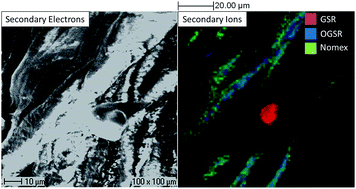Characterization of firearm discharge residues recovered from skin swabs using sub-micrometric mass spectrometry imaging†
Abstract
In the present work, we show the advantages of high spatial resolution interrogation of firearm discharge residues from skin swabs using ion bombardment coupled to mass spectrometry. In particular, the collection of secondary ion and electron maps permitted the chemical (organic and inorganic) and morphological characterization of particulates and organic compounds characteristic of gunshot residues (GSRs). Mass spectrometry imaging (MSI) permitted the characterization, at the nanometer level (∼300 nm resolution), of the composition of particulates and organic compounds from skin swabs. The observation of “consistent” and “characteristic” inorganic compounds (e.g., Sb–Pb–Ba) from single particulates permitted the unambiguous identification of GSRs from the skin swabs. In addition, the observation of characteristic secondary ions of nitroglycerin, nitrocellulose, ethyl centralite, dioctyl sulphosuccinate, and dibutyl phthalate suggested the presence of organic gunshot residues (OGSRs). That is, our results demonstrate that MSI-TOF-SIMS permits the analysis of skin swabs containing GSRs (or not) and OGSRs without the need for sample preparation and with little to no damage to the surface of the skin swabs (thus preserving the evidence for further analysis).


 Please wait while we load your content...
Please wait while we load your content...